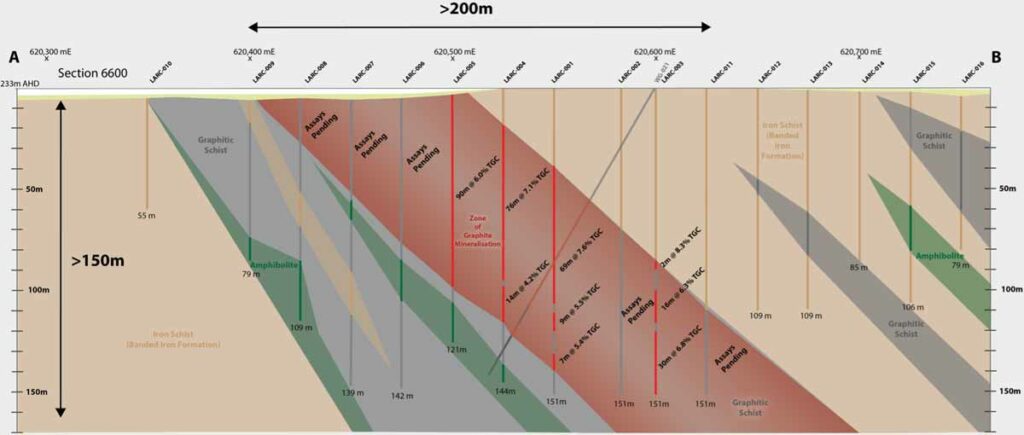WATCH: MD Mike Schwarz explains the scale of the Lacroma Graphite Prospect and the current drilling program.
HIGHLIGHTS
- Significant graphite assays from the first 4 drill holes at Central Lacroma include.
o LARC23-005 – 91m @ 6.0% TGC from 4m
o LARC23-004 – 76m @ 7.1% TGC from 19m
o LARC23-001 – 69m @ 7.6% TGC from 38m
o LARC23-003 – 2m @ 8.3% TGC from 85m, 16m @ 6.3% TGC from 102m and 30m @ 6.8% TGC from 121m
o LARC23-002 – Assays pending
- The first drill holes at Central Lacroma have defined an extensive graphite horizon.
- The mineralisation extends ~200m across strike, from surface to >150m deep, strikes NNW-SSE and dips 450 to the east, with a true thickness of ~ 60m.
- A second drill traverse, 1 km to the south, has confirmed continuation of the same graphite horizon along strike with assays pending.
- Drilling now confirms that the underlying >6km airborne electromagnetic anomaly is caused by a significant graphite mineralised system.
- Preliminary metallurgy, on graphite from historical drilling, demonstrates that a high-grade graphite concentrate of >90% TGC with recoveries of ~83% can be achieved with simple flotation.
- Drilling is ongoing, with approximately 2,800m of 10,000m completed to date.
“iTech is very pleased with the impressive assay results from the first drill holes at the Lacroma Graphite Prospect. The scale of the graphite mineralisation at Central Lacroma is becoming apparent, with a significant thickness of graphite mineralisation intersected in drilling from surface and in two traverses over 1 km apart. With a further 4 to 5 km of strike still to be tested in the current drill program, iTech hopes to establish a significant new graphite asset for the company.”
— Managing Director Mike Schwarz
DETAILS
Lacroma Graphite Prospect

The Lacroma Graphite Prospect is located approximately 20km south-west of Kimba on the central Eyre Peninsula and <20km from iTech’s proposed graphite processing plant for the Campoona Spherical Graphite Project. The graphite at this location occurs within the Paleoproterozoic Hutchison Group Metasediments and is likely to have formed from organic rich stratigraphic horizons metamorphosed during regional upper greenschist to lower amphibolite facies metamorphism during the Kimban Orogeny. The Central Lacroma graphite rich horizon forms a north-south trending structure with a shallow easterly dip. As the structure falls to depth to the east, it is thrust back to surface along a north-south fault to form the Eastern Lacroma Target, as interpreted from drilling and detailed airborne and ground-based electromagnetics.

Drill Results
Drill results from the first drill traverse at Lacroma have defined an extensive graphite horizon which extends ~200m across strike, from surface to >150m deep, strikes NNW-SSE and dips 450 to the east (Figure 2). Geological logging of the second drill traverse has shown that this same horizon occurs over 1 km to the south, consistent with iTech’s model that the 6km airborne electromagnetic anomaly is caused by a regionally extensive graphite horizon of scale. In addition to confirming the model, the following characteristics of mineralisation were also determined at the first traverse:
• The groundwater is significantly deeper in the zone of mineralisation with water consistently being intersected at 85m and a standing level of ~60m.
• Weathering is deep with little sulphide in the top 80-100m.
• Given that much of the mineralisation is at or very close to surface and the mineralised horizon dips at 450, the strip ratio is likely to be very favourable.
All these characteristics are favourable in a low-cost mining operation.
Holes were drilled at 25m intervals across the strike of the aeromagnetic anomaly to a maximum depth of 150m. Holes that did not achieve the maximum depth were generally limited by groundwater or difficult drilling conditions. Favourable drilling conditions were generally associated with good graphite mineralisation and resulted in the holes being terminated in graphite mineralisation, at 150m as planned, due to lack of drill rods.

RECENT NEWS FROM THE CAMPOONA GRAPHITE PROJECT

Ask iTech: Graphite Progress and Bulk Samples

Ask iTech: The Long-Term Graphite Strategy Explained


